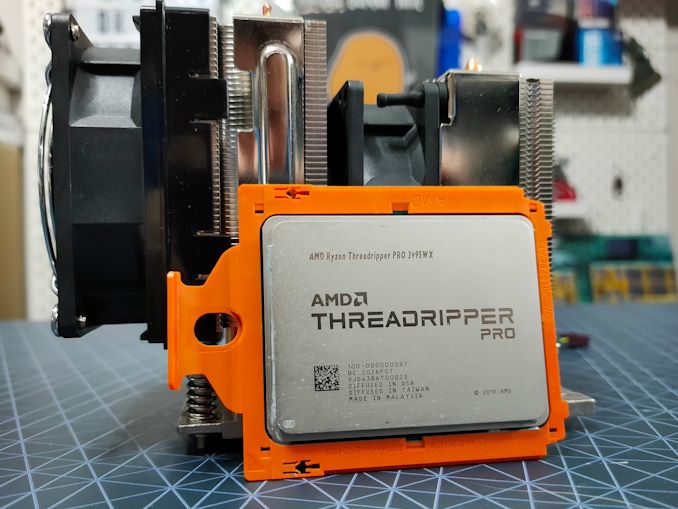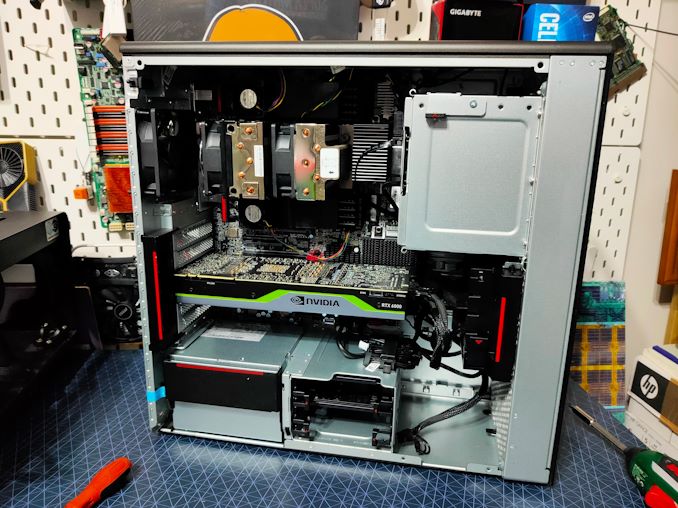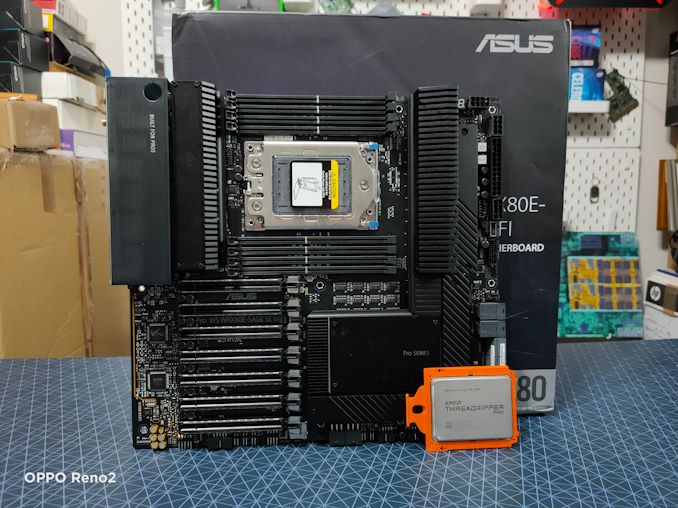64 Cores of Rendering Madness: The AMD Threadripper Pro 3995WX Review
by Dr. Ian Cutress on February 9, 2021 9:00 AM EST- Posted in
- CPUs
- AMD
- Lenovo
- ThinkStation
- Threadripper Pro
- WRX80
- 3995WX
Conclusions: Faster Than Expected
When I started testing for this review, looking purely at the specification sheet, I was expecting AMD’s Threadripper Pro 3995WX to come in just behind the 3990X in most of our testing. The same amount of cores, the same TDP, but slightly lower on frequencies in exchange for double the memory channels and 8x the memory support (also Pro features). More often than not our processor comparisons are usually testing systems with identical memory systems, or we don’t consider that memory difference that major in most of our testing. After going through the end data for this review, it would appear that it makes more of a difference than we initially had thought.
In the tests that matter, most noticeably the 3D rendering tests, we’re seeing a 3% speed-up on the Threadripper Pro compared to the regular Threadripper at the same memory frequency and sub-timings. The core frequencies were preferential on the 3990X, but the memory bandwidth of the 3995WX is obviously helping to a small degree, enough to pull ahead in our testing, along with the benefit of having access to 8x of the memory capacity as well as Pro features for proper enterprise-level administration.
The downside of this comparison is the cost: the SEP difference is +$1500, or another 50%, for the Threadripper Pro 3995WX over the regular Threadripper 3990X. With this price increase, you’re not really paying +50% for the performance difference (ECC memory also costs a good amount), but the feature set. Threadripper Pro is aimed at the visual effects and rendering market, where holding 3D models in main memory is a key aspect of workflow speed as well as full-scene production. Alongside the memory capacity difference, having double the PCIe 4.0 lanes means more access to offload hardware or additional fast storage, also important tools in the visual effects space. Threadripper Pro falls very much into the bucket of 'if you need it, this is the option to go for'.
For our testing, we used the Lenovo Thinkstation P620, the first Threadripper Pro system available in the market, and we’ll have a full review on it shortly. The Thinkstation Pro systems are always well designed workstations with longevity and professional workloads in mind, enabling 280 W cooling with a fun heatsink but also additional custom DRAM fans, a unique motherboard with an easily removable power supply, and support and space for a number of add-in cards. Lenovo’s units, if you buy them individually from the website, are eye-wateringly expensive (+$12200 for the 64-core CPU, a +120% markup), and it is recommended that any design studio that wants to test or order these units should work through a local distributor.
AMD is set to push Threadripper Pro into the consumer and commercial markets beyond Lenovo later this quarter. We have already been in touch with local regional system integrators who are already examining their options based on the three Threadripper Pro motherboards set to be available in the market from ASUS, GIGABYTE, and Supermicro. We are expecting a range of options to be available, and most design studios are likely to order pre-built systems with a variety of air and liquid cooling.
What might confuse a few users is that AMD is launching Threadripper Pro into the major market now, right on the cusp of its next-generation EPYC launch in the next eight weeks. These new EPYC processors should afford a sizeable raw compute upgrade moving to Zen 3 cores, all while Threadripper Pro is on Zen 2. As we saw comparing TR Pro to EPYC in this review, both on Zen 2, in some circumstances it is the push up to 280 W where TR Pro gets the best performance, and a 280 W version of next-generation EPYC might seem more appealing to users looking at TR Pro today. What exactly AMD will launch for EPYC is unknown, whereas TR Pro on this generation is now a known performance factor that system integrators are building on for the workstation market. EPYC never really fit into the workstation market that easily, which is why TR Pro exists today.
We have heard some conflicting dates as to when exactly Threadripper Pro will come to the mass market beyond Lenovo, but they all fall within Q1. We have reached out to AMD in order to source the other processors for our testing.














118 Comments
View All Comments
kwinz - Wednesday, February 10, 2021 - link
Really? CPUs are in high demand because GPU programming is hard? That's what you're going with?Gomez Addams - Wednesday, February 10, 2021 - link
Good heavens that was painful to read. Some of the worst writing have had to suffer through in a while. One tip : compute is a verb and not a noun, just as simulation is a noun and simulate is a verb. Just because marketing droids use a term does not mean it is correct.Spunjji - Thursday, February 11, 2021 - link
Sorry pal, language doesn't work that way. You may not *like* it, but that's the way it is!croc - Wednesday, February 10, 2021 - link
Are we now ignoring the elephant? EPYC was to launch in 2020. Actually, AMD said that Zen 3 would launch in 2020, but there's a weasel in them words... SOME of the Zen 3 cpu's DID launch, mostly looking like paper though. EPYC is sort-of launching as we speak, and Zen 3 Threadripper is a no-show.I have said this elsewhere, and I will say it here. It would appear that AMD's lack of fab experience is showing, as they seem to be having issues getting their designs to fab properly at 7nm. Low to no yields? And TSMC is having issues of their own with China buying up as much talent as it can, while threatening to just grab it all in a military takeover. TSMC should have already built an advanced fab somewhere in the west, out of China's reach. Europe? Canada? After Trump, I would say to avoid the US as much as it needs to avoid China.
Spunjji - Thursday, February 11, 2021 - link
AMD were hoping to get Milan into production in Q3 2020 and have it shipping to some customers by Q4, which they did. It's not available to OEMs yet, so hardly a fanfare moment, but not the "elephant" you're trying to paint it as either.Same goes for Zen 3, too - it absolutely wasn't a "paper launch" - but I see you're just here to push FUD rather than discuss *the article*.
Like, what's this "they seem to be having issues getting their designs to fab properly at 7nm" crap? Whose backside are you pulling that out of?
Amazing how many people seem to think these comment sections are the ideal place to grind their own personal political axes.
Oxford Guy - Thursday, February 11, 2021 - link
‘Amazing how many people seem to think these comment sections are the ideal place to grind their own personal political axes’You seem to think this is your personal website.
Qasar - Thursday, February 11, 2021 - link
as do you, point is ?Oxford Guy - Wednesday, March 10, 2021 - link
It’s not the tu quoque fallacy.tygrus - Thursday, February 11, 2021 - link
If total desktop sales were 20Million in 2020Q4 and if AMD sold 5M with about 0.95M being Zen3 so AMD could have been 19% of desktop CPU sales being Zen3. That's a good start and a lot better than <5% you may think happens for a paper launch. Notebook market adds another 50M/qtr (20% AMD?) and tablets (probably not AMD) on top of that so Zen3 sales would look like ~7% of AMD consumer CPU's sold that qtr.Not all sales & deliveries are publicised so server sales may have happened already for Zen3. The FAB capacity & yield were more than enough because it was the substrate & final assembly which limited supply.
ipkh - Sunday, February 28, 2021 - link
Really, they have Global Foundries to thank for this. Global Foundries miseead the market and decided to drop highend node production. This left TSMC as the only highend node company left standing (that does 3rd party fab). Global Foundries and Samsung could have had a much better roadmap working together with IBMs researchers. But they didn't and now we see how much it is costing the entire industry. AMD may be forced to use Samsung Foundries if TSMC production gets tied up.